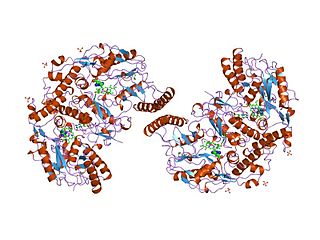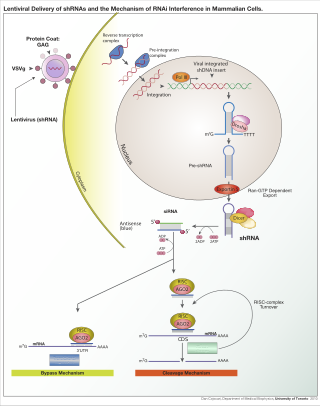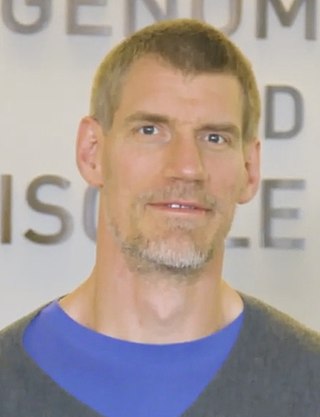Related Research Articles

Gene therapy is a medical technology that aims to produce a therapeutic effect through the manipulation of gene expression or through altering the biological properties of living cells.
Gene silencing is the regulation of gene expression in a cell to prevent the expression of a certain gene. Gene silencing can occur during either transcription or translation and is often used in research. In particular, methods used to silence genes are being increasingly used to produce therapeutics to combat cancer and other diseases, such as infectious diseases and neurodegenerative disorders.

Biogen Inc. is an American multinational biotechnology company based in Cambridge, Massachusetts, United States specializing in the discovery, development, and delivery of therapies for the treatment of neurological diseases to patients worldwide. Biogen operates in Argentina, Brazil, Canada, China, France, Germany, Hungary, India, Italy, Japan, Mexico, Netherlands, Poland, Sweden, and Switzerland.
Antisense therapy is a form of treatment that uses antisense oligonucleotides (ASOs) to target messenger RNA (mRNA). ASOs are capable of altering mRNA expression through a variety of mechanisms, including ribonuclease H mediated decay of the pre-mRNA, direct steric blockage, and exon content modulation through splicing site binding on pre-mRNA. Several ASOs have been approved in the United States, the European Union, and elsewhere.
Tom Maniatis, is an American professor of molecular and cellular biology. He is a professor at Columbia University, and serves as the Scientific Director and CEO of the New York Genome Center.
An attenuated vaccine is a vaccine created by reducing the virulence of a pathogen, but still keeping it viable. Attenuation takes an infectious agent and alters it so that it becomes harmless or less virulent. These vaccines contrast to those produced by "killing" the pathogen.

Nitric oxide synthase, inducible is an enzyme which is encoded by the NOS2 gene in humans and mice.

Interferon regulatory factor 7, also known as IRF7, is a member of the interferon regulatory factor family of transcription factors.

Gladstone Institutes is an independent, non-profit biomedical research organization whose focus is to better understand, prevent, treat and cure cardiovascular, viral and neurological conditions such as heart failure, HIV/AIDS and Alzheimer's disease. Its researchers study these diseases using techniques of basic and translational science. Another focus at Gladstone is building on the development of induced pluripotent stem cell technology by one of its investigators, 2012 Nobel Laureate Shinya Yamanaka, to improve drug discovery, personalized medicine and tissue regeneration.

RNA interference (RNAi) is a biological process in which RNA molecules are involved in sequence-specific suppression of gene expression by double-stranded RNA, through translational or transcriptional repression. Historically, RNAi was known by other names, including co-suppression, post-transcriptional gene silencing (PTGS), and quelling. The detailed study of each of these seemingly different processes elucidated that the identity of these phenomena were all actually RNAi. Andrew Fire and Craig C. Mello shared the 2006 Nobel Prize in Physiology or Medicine for their work on RNAi in the nematode worm Caenorhabditis elegans, which they published in 1998. Since the discovery of RNAi and its regulatory potentials, it has become evident that RNAi has immense potential in suppression of desired genes. RNAi is now known as precise, efficient, stable and better than antisense therapy for gene suppression. Antisense RNA produced intracellularly by an expression vector may be developed and find utility as novel therapeutic agents.
Dr Vinod Scaria FRSB, FRSPH is an Indian biologist, medical researcher pioneering in Precision Medicine and Clinical Genomics in India. He is best known for sequencing the first Indian genome. He was also instrumental in the sequencing of The first Sri Lankan Genome, analysis of the first Malaysian Genome sequencing and analysis of the Wild-type strain of Zebrafish and the IndiGen programme on Genomics for Public Health in India.

HIV/AIDS research includes all medical research that attempts to prevent, treat, or cure HIV/AIDS, as well as fundamental research about the nature of HIV as an infectious agent and AIDS as the disease caused by HIV.
The Icahn Genomics Institute is a biomedical and genomics research institute within the Icahn School of Medicine at Mount Sinai in New York City. Its aim is to establish a new generation of medicines that can better treat diseases afflicting the world, including cancer, heart disease and infectious pathogens. To do this, the institute’s doctors and scientists are developing and employing new types of treatments that utilize DNA and RNA based therapies, such as CRISPR, siRNA, RNA vaccines, and CAR T cells, and searching for novel drug targets through the use of functional genomics and data science. The institute is led by Brian Brown, a leading expert in gene therapy, genetic engineering, and molecular immunology.

Andrew Kasarskis is an American biologist. He is the Chief Data Officer (CDO) at Sema4. He was previously CDO and an Executive Vice President (EVP) at the Mount Sinai Health System in New York City and, before that, vice chair of the Department of Genetics and Genomic Sciences and Co-director of the Icahn Institute for Genomics and Multiscale Biology at the Icahn School of Medicine at Mount Sinai. Kasarskis is known for taking a network-based approach to biology and for directing the first medical school class offering students the opportunity to fully sequence and analyze their own genomes.

Akiko Iwasaki is a Sterling Professor of Immunobiology and Molecular, Cellular and Developmental Biology at Yale University. She is also a principal investigator at the Howard Hughes Medical Institute. Her research interests include innate immunity, autophagy, inflammasomes, sexually transmitted infections, herpes simplex virus, human papillomavirus, respiratory virus infections, influenza infection, T cell immunity, commensal bacteria, COVID-19, and long COVID.

Derrick J. Rossi, is a Canadian stem cell biologist and entrepreneur. He is a co-founder of the pharmaceutical company Moderna.

An mRNAvaccine is a type of vaccine that uses a copy of a molecule called messenger RNA (mRNA) to produce an immune response. The vaccine delivers molecules of antigen-encoding mRNA into immune cells, which use the designed mRNA as a blueprint to build foreign protein that would normally be produced by a pathogen or by a cancer cell. These protein molecules stimulate an adaptive immune response that teaches the body to identify and destroy the corresponding pathogen or cancer cells. The mRNA is delivered by a co-formulation of the RNA encapsulated in lipid nanoparticles that protect the RNA strands and help their absorption into the cells.

The MRC Weatherall Institute of Molecular Medicine at the University of Oxford is a research institute located at the John Radcliffe Hospital in Oxford. Founded in 1989 by Sir David Weatherall, the institute focuses on furthering our understanding of clinical medicine at a molecular level. It was one of the first institutes of its kind in the world to be dedicated to research in this area.
Endothelial cell tropism or endotheliotropism is a type of tissue tropism or host tropism that characterizes an pathogen's ability to recognize and infect an endothelial cell. Pathogens, such as viruses, can target a specific tissue type or multiple tissue types. Like other cells, the endothelial cell possesses several features that supports a productive viral infection a cell including, cell surface receptors, immune responses, and other virulence factors. Endothelial cells are found in various tissue types such as in the capillaries, veins, and arteries in the human body. As endothelial cells line these blood vessels and critical networks that extend access to various human organ systems, the virus entry into these cells can be detrimental to virus spread across the host system and affect clinical course of disease. Understanding the mechanisms of how viruses attach, enter, and control endothelial functions and host responses inform infectious disease understanding and medical countermeasures.
Howard E. Gendelman is an American physician-scientist whose research intersects the disciplines of neuroimmunology, pharmacology, and infectious diseases. Gendelman was born in Philadelphia, Pennsylvania. His research is focused on harnessing immune responses for therapeutic gain in HIV/AIDS and Neurodegenerative disease. He is the Margaret R. Larson Professor of infectious diseases and internal medicine at the University of Nebraska Medical Center (UNMC) in Omaha.
References
- ↑ Peters, Rob; Harris, Tim (2018). "Advances and innovations in haemophilia treatment". Nature Reviews. Drug Discovery. 17 (7): 493–508. doi:10.1038/nrd.2018.70. ISSN 1474-1784. PMID 29880919. S2CID 46953806.
- ↑ "Biogen, ALS Association, Columbia to Study ALS Genomics in 1,500 Patients (GenomeWeb) | Technology Ventures". techventures.columbia.edu. Retrieved 19 February 2021.
- ↑ "Tim Harris, Ph.D., D.Sc". GoldLab Foundation. Retrieved 19 February 2021.
- ↑ "Honorary graduands for July 2010". Birmingham.ac.uk. 19 February 2021.
- ↑ "Biogen partners with Columbia to find genetic 'signposts' of ALS". www.bizjournals.com. Retrieved 19 February 2021.
- ↑ "Industry veteran brings expertise to Bioverativ". www.thepharmaletter.com. Retrieved 19 February 2021.
- ↑ Harris, Tim; Papadopoulos, Stelios; Goldstein, David B. (1 June 2015). "Academic–industrial partnerships in drug discovery in the age of genomics". Trends in Biotechnology. 33 (6): 320–322. doi:10.1016/j.tibtech.2015.02.009. ISSN 0167-7799. PMID 25987446.
- ↑ "New faces at the Bionomics". labonline.com.au. Retrieved 19 February 2021.
- ↑ "Tim Harris - EVP, Corporate Development at Repertoire Immune Medicines". THE ORG. Retrieved 19 February 2021.
- ↑ "Tim Harris, DSc, PhD • Repertoire Immune Medicines". Repertoire Immune Medicines. Retrieved 19 February 2021.
- ↑ "Bioverativ Appoints Tim Harris Executive Vice President, Research and Development". www.businesswire.com. 10 April 2017. Retrieved 19 February 2021.
- ↑ "The Protein Hunters". Wired. ISSN 1059-1028 . Retrieved 19 February 2021.
- ↑ Harris, Tim; Buckler, Alan (1997). "In defense of genomics". Nature Biotechnology. 15 (9): 820–1. doi: 10.1038/nbt0997-820 . ISSN 1546-1696. PMID 9306388. S2CID 40600192.
- ↑ "Tim Harris". SV Health Investors. Retrieved 19 February 2021.
- ↑ "Bioverativ : Appoints Tim Harris Executive Vice President, Research and Development | MarketScreener". m.marketscreener.com. Retrieved 19 February 2021.
- ↑ "Dr. Tim Harris". HSTalks. Retrieved 19 February 2021.
- ↑ Cirulli,E., et al., (2015) (2015). "Exome sequencing in amyotrophic lateral sclerosis identifies risk genes and pathways". Science. 347 (6229): 1436–41. Bibcode:2015Sci...347.1436C. doi:10.1126/science.aaa3650. PMC 4437632 . PMID 25700176.
{{cite journal}}: CS1 maint: multiple names: authors list (link) CS1 maint: numeric names: authors list (link) - ↑ Estrada, Karol; et al. 2018 (2018). "A whole-genome sequence study identifies genetic risk factors for neuromyelitis optica". Nature Communications. 9 (1): 1929. Bibcode:2018NatCo...9.1929E. doi:10.1038/s41467-018-04332-3. ISSN 2041-1723. PMC 5955905 . PMID 29769526.
{{cite journal}}: CS1 maint: multiple names: authors list (link) CS1 maint: numeric names: authors list (link) - ↑ Sauer, Karsten; Harris, Tim (2020). "An Effective COVID-19 Vaccine Needs to Engage T Cells". Frontiers in Immunology. 11: 581807. doi: 10.3389/fimmu.2020.581807 . ISSN 1664-3224. PMC 7549399 . PMID 33117391.
- ↑ Harris, Tim; Sauer, Karsten (17 February 2021). "Are T cell repertoires useful as diagnostics for SARS-CoV-2 infection?". Expert Review of Molecular Diagnostics. 21 (2): 137–139. doi:10.1080/14737159.2021.1882852. ISSN 1473-7159. PMC 7898294 . PMID 33595410.